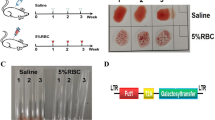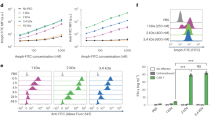Abstract
Galactose(α1,3)galactose on the surface of cells of non-primate organs is the major xenoantigen responsible for hyperacute rejection in xenotransplantation. The antigen is synthesised by (α1,3)galactosyl transferase. Humans lack this enzyme and their serum contains high levels of pre-existing natural antibody which recognises the structure and activates complement. We have evaluated in vitro the potential for delivery of this enzyme to sensitise human cells to complement attack as a gene therapy approach to cancer. Retrovirus-mediated delivery of (α1,3)galactosyl transferase resulted in high level expression which led to serum-mediated lysis of five human cell targets, including endothelial and primary melanoma cells. Lysis was specific for those cells expressing the antigen in a mixed cell population. The mechanism of cell lysis mimicked that involved in hyperacute rejection: activation of the classical complement pathway by natural antibody specific for galactose(α1,3)galactose. The degree of lysis was determined by both the level of specific antibody and the expression of glycophosphatidylinositol-linked complement regulatory proteins. We conclude that expression of (α1,3)galactosyl transferase is a promising new therapeutic approach for cancer gene therapy, avoiding toxicity problems associated with application of prodrugs and with the potential to elicit further immunological responses.
This is a preview of subscription content, access via your institution
Access options
Subscribe to this journal
Receive 12 print issues and online access
$259.00 per year
only $21.58 per issue
Buy this article
- Purchase on Springer Link
- Instant access to full article PDF
Prices may be subject to local taxes which are calculated during checkout







Similar content being viewed by others
References
Platt JL et al. Immunopathology of hyperacute xenograft rejection in a swine-to-primate model Transplantation 1991 52: 214–220
Dalmasso AP et al. Mechanism of complement activation in the hyperacute rejection of porcine organs transplanted into primate recipients Am J Pathol 1992 140: 1157–1166
Sandrin MS, Vaughan HA, Dabkowski PL, McKenzie IFC . Anti-pig IgM antibodies in human serum react predominantly with Gal(alpha1,3)Gal epitopes Proc Natl Acad Sci USA 1993 90: 11391–11395
Vaughan HA, Loveland BE, Sandrin MS . Gal-alpha(1,3)-Gal is the major xenoepitope expressed on pig endothelial cells recognized by naturally occurring cytotoxic human antibodies Transplantation 1994 58: 879–882
Vaughan HA, Dabkowski PL, McKenzie IFC, Sandrin MS . Biochemical analysis of pig xenoantigens detected by human antibodies Transplantation Proc 1993 25: 2919–2920
Paulson JC, Colley KJ . Glycosyltransferases: structure, localization, and control of cell type-specific glycosylation J Biol Chem 1989 264: 17615–17618
Galili U et al. Evolutionary relationship between the natural anti-Gal antibody and the Gal alpha1–3 Gal epitope in primates Proc Natl Acad Sci USA 1987 84: 1369–1373
Galili U et al. Interaction between human natural anti-alpha-galactosyl immunoglobulin G and bacteria of the human flora Infect Immunol 1988 56: 1730–1737
Galili U . Interaction of the natural anti-Gal antibody with alpha-galactosyl epitopes: a major obstacle for xenotransplantation in humans Immunol Today 1993 14: 480–482
Galili U et al. One percent of human circulating B lymphocytes are capable of producing the natural anti-Gal antibody Blood 1993 82: 2485–2493
Galili U, Rachmilewitz EA, Peleg A, Flechner I . A unique natural human IgG antibody with anti-alpha-galactosyl specificity J Exp Med 1984 160: 1519–1531
McMorrow IM, Comrack CA, Sachs DH, DerSimonian H . Heterogeneity of human anti-pig natural antibodies cross-reactive with the Gal(alpha1,3)Galactose epitope Transplantation 1997 64: 501–510
Takeuchi Y et al. Sensitization of cells and retroviruses to human serum by (alpha 1–3) galactosyltransferase Nature 1996 379: 85–88
Reed DJ et al. Alteration of glycosylation renders HIV sensitive to inactivation by normal human serum J Immunol 1997 159: 4356–4361
Sandrin MS et al. Enzymatic remodelling of the carbohydrate surface of a xenogeneic cell substantially reduces human antibody binding and complement-mediated cytolysis Nature Med 1995 1: 1261–1267
Osman N, McKenzie IFC, Mouhtouris E, Sandrin MS . Switching amino-terminal cytoplasmic domains of alpha(1,2)fucosyl transferase and alpha(1,3)galactosyl transferase alters the expression of H substance and Gal-alpha(1,3)-Gal J Biol Chem 1996 271: 33105–33109
Rother RP et al. A novel mechanism of retrovirus inactivation in human serum mediated by anti-α-galactosyl natural antibody J Exp Med 1995 182: 1345–1355
Cairns T et al. Inhibition of the pig to human xenograft reaction using soluble GALα1–3GAL and GALβ1–3GALβ1-GlcNAc Transplantation 1995 60: 1202–1207
Morgan BP, Meri S . Membrane proteins that protect against complement lysis Springer Semin Immunopathol 1994 15: 369–396
Cozzi E, White DJ . The generation of transgenic pigs as potential organ donors for humans Nature Med 1995 1: 964–966
McCurry KR et al. Human complement regulatory proteins protect swine-to-primate cardiac xenografts from humoral injury Nature Med 1995 1: 423–427
Collins BH et al. Cardiac xenografts between primate species provide evidence for the importance of the alpha-galactosyl determinant in hyperacute rejection J Immunol 1995 154: 5500–5510
McMorrow IM et al. Relationship between ABO blood group and levels of Gal-alpha1,3-Galactose-reactive human immunoglobulin G Transplantation 1997 64: 546–549
Maenpaa A et al. Expression of complement membrane regulators membrane cofactor protein (CD46), decay accelerating factor (CD55), and protectin (CD59) in human malignant gliomas Am J Pathol 1996 148: 1139–1152
Bjorge L et al. Complement-regulatory proteins in ovarian malignancies Int J Cancer 1997 70: 14–25
LaTemple DC, Henion TR, Anaraki F, Galili U . Synthesis of alpha-galactosyl epitopes by recombinant alpha1,3galactosyl transferase for opsonization of human tumor cell vaccines by anti-galactose Cancer Res 1996 56: 3069–3074
Galili U, LaTemple DC . Natural anti-Gal antibody as a universal augmenter of autologous tumor vaccine immunogenicity Immunol Today 1997 18: 281–285
Wang L, Anaraki F, Henion TR, Galili U . Variations in activity of the human natural anti-Gal antibody in young and elderly populations J Gerontol 1995 50A: M227–M233
Patel PM et al. Generation of interleukin-2-secreting melanoma cell populations from resected metastatic tumors Hum Gene Ther 1994 5: 577–584
Strahan KM et al. cDNA sequence and chromosome location of pig alpha1,3 galactosyltransferase Immunogenetics 1995 41: 101–105
Dranoff G et al. Vaccination with irradiated tumor cells engineered to secrete murine granulocyte–macrophage colony-stimulating factor stimulates potent, specific, and long-lasting anti-tumor immunity Proc Natl Acad Sci USA 1993 90: 3539–3543
Cosset F-L et al. High titre packaging cells producing recombinant retroviruses resistant to human serum J Virol 1995 69: 7430–7436
Davies A et al. CD59, an LY-6-like protein expressed in human lymphoid cells, regulates the action of complement membrane attack complex in homologous cells J Exp Med 1989 170: 637–654
Armitage P, Berry G . Statistical Methods in Medical Research, 2nd edn Blackwell Scientific: Oxford 1987
Acknowledgements
We thank Dr Kenth Gustafsson for helpful discussion and for supplying the plasmid pSα13GT, under an agreement with BioTransplant Inc.; Dr Ian Titley for flow sorting transduced cell populations; Dr Kevin Davies for analysis of serum components and complement activity; Dr Philip Judson for provision of sera and antibodies BRIC216/229; and Dr Peter Lachmann for antibody YTH53.1. We are grateful to Professors Mary Collins, Chris Marshall and Robin Weiss for support and critical discussion. This work was funded by the Medical Research Council.
Author information
Authors and Affiliations
Rights and permissions
About this article
Cite this article
Jäger, U., Takeuchi, Y. & Porter, C. Induction of complement attack on human cells by Gal(alpha1,3)Gal xenoantigen expression as a gene therapy approach to cancer. Gene Ther 6, 1073–1083 (1999). https://doi.org/10.1038/sj.gt.3300934
Received:
Accepted:
Published:
Issue Date:
DOI: https://doi.org/10.1038/sj.gt.3300934
Keywords
This article is cited by
-
Complement insufficiency limits efficacy in a xenograft model of hyperacute rejection for cancer therapy
Cancer Immunology, Immunotherapy (2007)
-
Co-expression of α(1,3)galactosyltransferase and Bacillus thuringiensis PIPLC enhances hyperacute rejection of tumor cells
Cancer Immunology, Immunotherapy (2006)
-
In vivo targeting of vaccinating tumor cells to antigen-presenting cells by a gene therapy method with adenovirus containing the α1,3galactosyltransferase gene
Cancer Gene Therapy (2005)



